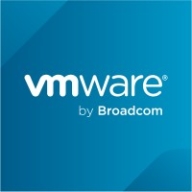

KVM and VMware vSphere compete in the virtualization solutions category. VMware vSphere seems to have the upper hand due to its robust management capabilities and extensive support for enterprise-level tools, despite its higher cost and complexity.
Features: KVM is known for its open-source nature, high-performance live migrations, and scalability. It seamlessly integrates with open-source components, allowing extensive customization. VMware vSphere offers centralized management, supports diverse guest OS, and includes advanced features like VMotion and DRS for real-time VM migration, which caters to enterprise needs.
Room for Improvement: KVM faces issues with complex setups, networking configurations, and lacks user-friendly interfaces for Linux novices. It needs better support for Windows guests and enhanced VM scaling features. VMware vSphere is criticized for high costs and licensing complexities. Users request improvements in web interface, better fault tolerance, and reduced dependency on additional paid features.
Ease of Deployment and Customer Service: KVM is flexible with deployments, primarily community-supported unless coupled with a Red Hat subscription. This can be challenging for users needing dedicated support. VMware vSphere is widely used in hybrid setups and provides highly regarded enterprise-level support, making it more structured than KVM's community-driven model.
Pricing and ROI: KVM is cost-effective with zero licensing fees, appealing to organizations with Linux expertise. VMware vSphere requires significant financial investment but justifies its price with its comprehensive feature set and enterprise support, offering higher ROI for large deployments needing strong management capabilities.
KVM definitely saves costs since it is open-source and does not obligate us to pay for licenses as necessary with other virtualization solutions.
We can say 10% is the approximate amount of savings because most of the things are automated and streamlined, so the manual work is eliminated in most cases.
Paid support is also obtainable from companies like Red Hat for more critical issues.
The quality of support should be improved; overall quality.
If we have issues, the support tends to be unreliable
Recently, support has been less friendly and slower, especially after the company was acquired by Broadcom.
It is a highly scalable solution.
Scaling is easy, whether it is hyperconverged or a three-tier architecture.
VMware vSphere is highly scalable in terms of the number of users and the number of servers it can handle.
While they are generally stable, if outages occur, they tend to be due to brands like HP or Dell, not VMware vSphere itself.
It is a very stable hypervisor solution.
Mostly we don't have issues, but sometimes we have faced some stability issues because of some bugs and some CPU compatibility issues with Intel CPUs.
In comparison to VMware, which offers a more balanced set of management features, KVM could improve in terms of user-friendly tooling.
Another area is the stability during upgrades from older versions to newer versions, where we face issues.
VMware vSphere has a built-in feature called Fault Tolerance, but it's very limited for very limited VMs or very limited core count or CPU count, so it's not so useful for all the environment because of the limitations.
Sometimes, it is difficult to find documentation for specific tools and solutions.
Compared to VMware and Microsoft, KVM offers better pricing and licensing options.
Many customers are trying to avoid it due to its high cost.
About three or four years ago, I would have recommended VMware vSphere more strongly, but currently, the price and licensing issues are deterrents.
Costs significantly increased from perpetual to subscription, with prices rising by two to three times over three to five years.
The most valuable feature of KVM is its superior real-time performance, which results in lower latency compared to alternatives like VMware and Microsoft.
The tool is highly available, which is crucial for implementing critical applications requiring 24/7 availability.
The vMotion feature is beneficial for online migration of virtual machines from one host to another without downtime.
I always use VMware vSphere vMotion; we work with this feature all the time. vMotion is very useful; that's why we use the virtualization.
| Product | Market Share (%) |
|---|---|
| VMware vSphere | 17.0% |
| KVM | 9.4% |
| Other | 73.6% |




| Company Size | Count |
|---|---|
| Small Business | 22 |
| Midsize Enterprise | 9 |
| Large Enterprise | 14 |
| Company Size | Count |
|---|---|
| Small Business | 174 |
| Midsize Enterprise | 137 |
| Large Enterprise | 256 |
KVM stands for Kernel-based Virtual Machine, which is an open-source virtualization technology that is embedded in Linux. KVM allows users to seamlessly transform their Linux system into a hypervisor that, in turn, will enable a host machine to run numerous, isolated virtual environments or virtual machines (VMs).
KVM is part of Linux. Users with Linux 2.6.20 or newer already have KVM. As KVM is already a component of the current Linux code, it automatically improves with every new Linux fix, feature, or upgrade. So KVM users are always current and up to date.
KVM automatically transforms Linux to a type -1 (bare-metal) hypervisor. All hypervisors need operating system components, such as a process scheduler, I/O stack, device drivers, memory manager, and more, to run a VM. KVM already has these components embedded, as it is part of the Linux kernel. Each VM is generated as a basic Linux proces,s which is maintained by the standard Linux scheduler, with dedicated hardware such as a graphics adapter, memory, disks, network card, and CPUs.
KVM Key Features:
KVM has many valuable key features. Some of its most useful features include:
Reviews from Real Users
“The most helpful aspect of KVM is the fact that the interface is so minimal. It includes just what you need to set up the VMs and manage them, and it's very simple to do so. KVM, as a native virtualization solution, is a complete and fully adequate system for small businesses that need to reduce costs, and also to make maintenance easier. “ - Georges E., Business Engineer and Consultant at All-Tech
“The most valuable feature of KVM is the hypervisor environment and how we can configure it with ease. Additionally, the interface is intuitive.” Sonu S., Senior Solution Architect at Micro Focus
VMware vSphere is a versatile virtualization platform known for its ease of use, flexibility, and high availability. It supports seamless migration, optimal resource allocation, and centralized management, making it highly suitable for diverse infrastructure needs.
VMware vSphere is widely adopted for its virtualization capabilities that enhance hardware efficiency and ensure minimal downtime through features like High Availability and Distributed Resource Scheduler. Despite criticisms about high licensing costs and limited fault tolerance, it remains a preferred choice due to its stability, scalability, and robust integration options. Users appreciate its efficiency in managing virtual machines and hosting enterprise applications, although challenges with web client performance and hardware compatibility are noted. Organizations often look for better integration with cloud services and enhanced automation and scalability.
What are the core features of VMware vSphere?
What benefits and ROI can businesses look for?
VMware vSphere is implemented across sectors like healthcare, finance, and education for server virtualization, data center management, and private cloud creation. Its use in facilitating business-critical operations ensures high availability and efficient resource use, supporting both development and production environments.
We monitor all Server Virtualization Software reviews to prevent fraudulent reviews and keep review quality high. We do not post reviews by company employees or direct competitors. We validate each review for authenticity via cross-reference with LinkedIn, and personal follow-up with the reviewer when necessary.